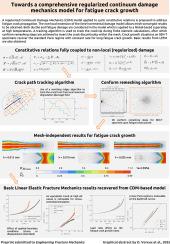Towards a comprehensive regularized continuum damage mechanics model for fatigue crack growth
IF 5.3
2区 工程技术
Q1 MECHANICS
引用次数: 0
Abstract
Efficient crack propagation models are required to ensure that critical parts of an aircraft continue to perform their function even in the presence of cracks. One of the main difficulties is to model the different types of damage that can occur in the same formalism given the variety of loading paths during in-service conditions that these parts are subjected to. To meet this challenge, incremental models are of particular interest, especially those based on Continuum Damage Mechanics (CDM). However, in order to obtain mesh-independent results, these models require the use of regularization methods. In addition, to check the ability of the model to catch the crack growth kinetics when the model is intrinsically continuous, a damage-to-crack transition is required in order to monitor the crack size. All these issues need to be addressed before any comparison can be made between numerical results from finite element calculations and those from a conventional Linear Elastic Fracture Mechanics (LEFM) approach. This paper proposes a possible solution by combining a regularized time-incremental model that takes into account two different types of damage (here fatigue and ductile damage) with a continuous–discontinuous strategy to insert an easy-to-track discrete crack. The procedure is investigated on a nickel-based superalloy subjected to fatigue loading conditions at elevated temperatures. The high-temperature cyclic behavior of the material is modeled within the framework of unified elastic–viscoplasticity. The discrete crack, within structural calculations, is represented by successive crack-path tracking and remeshing steps. Finite element calculations illustrate the ability of the proposed strategy to recover features identical to those obtained with conventional LEFM methods.

建立疲劳裂纹扩展的综合正则连续损伤力学模型
有效的裂纹扩展模型需要确保飞机的关键部件即使在存在裂纹的情况下也能继续发挥其功能。其中一个主要的困难是,考虑到这些部件在使用条件下所承受的各种加载路径,以相同的形式对可能发生的不同类型的损伤进行建模。为了应对这一挑战,增量模型受到了特别的关注,特别是基于连续损伤力学(CDM)的模型。然而,为了获得与网格无关的结果,这些模型需要使用正则化方法。此外,为了检查模型在本质连续时捕捉裂纹扩展动力学的能力,需要进行损伤到裂纹的转变以监测裂纹尺寸。在将有限元计算的数值结果与传统的线弹性断裂力学(LEFM)方法的数值结果进行比较之前,所有这些问题都需要解决。本文提出了一种可能的解决方案,即将考虑两种不同类型损伤(疲劳损伤和延性损伤)的正则化时间增量模型与插入易于跟踪的离散裂纹的连续-不连续策略相结合。在高温疲劳载荷条件下对镍基高温合金进行了试验研究。材料的高温循环行为是在统一的弹粘塑性框架内建模的。在结构计算中,离散裂纹由连续的裂纹路径跟踪和重网格步骤表示。有限元计算表明,所提出的策略能够恢复与传统LEFM方法相同的特征。
本文章由计算机程序翻译,如有差异,请以英文原文为准。
求助全文
约1分钟内获得全文
求助全文
来源期刊
CiteScore
8.70
自引率
13.00%
发文量
606
审稿时长
74 days
期刊介绍:
EFM covers a broad range of topics in fracture mechanics to be of interest and use to both researchers and practitioners. Contributions are welcome which address the fracture behavior of conventional engineering material systems as well as newly emerging material systems. Contributions on developments in the areas of mechanics and materials science strongly related to fracture mechanics are also welcome. Papers on fatigue are welcome if they treat the fatigue process using the methods of fracture mechanics.

 求助内容:
求助内容: 应助结果提醒方式:
应助结果提醒方式:


